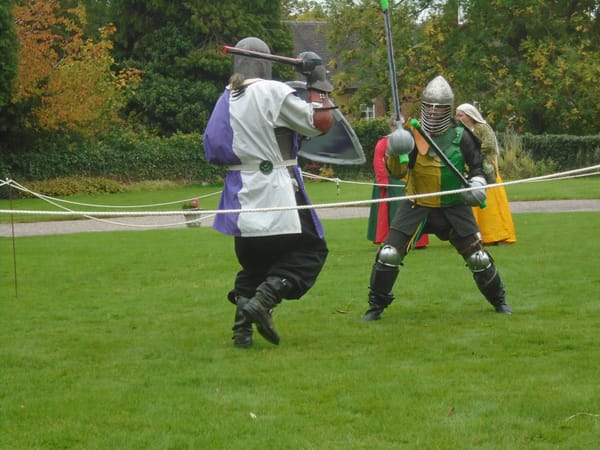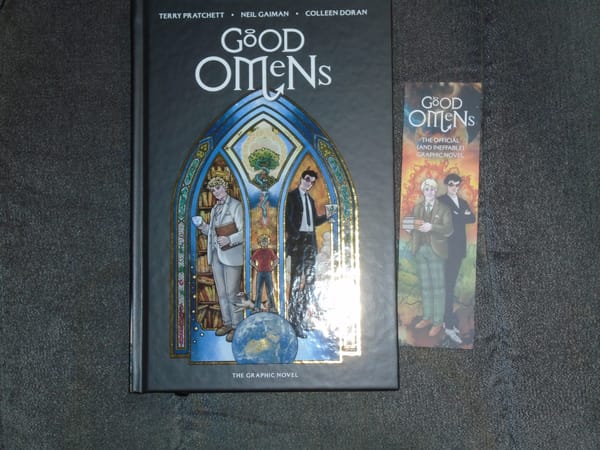Making (your own) history

I have the first skirt which is suitable for mediaeval garb; at that point - in fact, for the entire Middle Ages and earlier periods of European history - you had a choice of linen or wool, and if you were feeling really fancy you could mix them, and so everything I make has to look like one of those two fibres. In this case, it looks like linen, but it's actually polyester; I don't use that much, but this is deadstock, so using it saves it from ending up in landfill. It is cheap and cheerful, has a very good linen effect, and is a dream to sew with (other than the fact that it does fray like stink). I finished that on Saturday night and have nearly finished the tie belt that goes with it; I won't be wearing that for garb purposes, as I have a pretend-leather belt that fastens in the approved mediaeval fashion (in other words, it goes through a ring and then you knot it over the ring, leaving one long end dangling at the front). However, I'll want it for when I'm wearing the skirt for everyday use.
I'd actually ordered that fabric before I even knew there was an active SCA chapter in the area, so it was just happy chance that it turned out to work for garb. But once I'd started making the skirt, I rapidly realised that it would, which meant I also needed to order some more fabric to make a top half to go with it; this isn't quite so urgent in this weather, because I can just wear the tunic (the next thing on the sewing list) over the skirt and pretend I'm wearing a sleeveless dress, but I'll need it once it starts going a bit cooler. That meant finding a long-sleeved woven T-shirt pattern for non-stretch fabrics, and, because really all you see under the tunic is the sleeves, it also meant I could get away with decent shaping... which didn't really start to be invented until about the 11th or 12th century. Put it this way, the tunic will be a rectangle with armholes (and maybe a little bit of scoop at the front of the neck), and the only thing giving it shape will be the belt; I originally thought I'd be making a T-tunic with straight armhole seams, because they certainly had those, but then I realised it would be wide enough that the top of the rectangle would fall into sleeves about the right length, so I didn't need to add any more on. But for the top underneath, which I'll also be able to wear with the skirt as a mock dress, shaping is fine.
So I ordered the Verdun. What sold it to me was that someone in one of the comments said you didn't have to trace the pattern (I have been caught out by a few independent pattern manufacturers who print the pattern pieces on top of one another, thereby forcing you to do this). Sadly, what I didn't realise was that there were no metric measurements on it at all. It's American. Everything is in inches. I was rather thrown for a loop there, because after all, the mainstream pattern companies are also American, but they do metric measurements as well, because they know they're selling to the rest of the world, not just America. Liesl & Co, however, don't quite seem to have figured this out yet.
Fortunately I'm quite good at converting in my head if pushed (and I was pushed - it was late at night when I got the pattern out to look at it, and I was bothered if I was going to go back into the living room to get my calculator out); so I decided I could probably get away with size Large. It does only go up to a D cup, though that's at least better than most mainstream patterns, which implicitly assume everyone's a B cup (spoiler: they're not!). So at the moment I'm not sure whether to tweak the bust darts a bit more, or just leave them as they are on the grounds that I'm never going to be wearing this thing untucked, so I'll get some shaping from the waistband of the skirt (or whatever else I wear it with - it needn't necessarily be the matching skirt). One thing I do know, however, is that that weird shaped hem is going to go. There is absolutely no point in having it. It's going to be cut flat across at the bottom.
The slash neckline is also going; I don't especially like it and it's not necessary to get the thing on. The neckline will be as it is for the short-sleeved version. And, honestly, if you wear an E cup you do not want a silly little patch pocket sitting right on top of your boob, because if you put anything in that pocket it looks weird, and if you don't, then why have the pocket there at all?
Oh, and I won't be doing the facings as they stand. It'll either be bias binding if I can find some the right colour (I think all I have is black at the moment, but I'll check), or possibly a bit of ribbon (I definitely do have some of that in the right colour, having just made the hanging loops for the skirt from it). This is because the neckline may just show under the tunic, and facings are very modern inventions. Mediaeval garments had narrow hems at the openings instead, and if I were using real linen I'd do that. This stuff frays too much (and has a bit too much bounce) to make a narrow hem a sensible option, so bias binding or ribbon seems like the best compromise.
Also, you know I said I'd thought about making my own turnshoes but decided it would be both slow and expensive, so I bought a pair of near-enough mediaeval shoes from Etsy? On Thursday it rained (yay!) and I had to go out (not quite so yay); and I wasn't sure what to put on my feet, because it's so dry in East Anglia in the summer that I've never really had any summer wet-weather shoes. And then I thought of the mediaeval-ish shoes, and they turned out to be perfect... not to mention super comfortable. (They are, of course, actually foot-shaped. It wasn't till about the 16th or 17th century that people started inventing non-foot-shaped shoes. I'm very sorry they caught on.) Granted, I don't want anyone peering too closely at the fittings (not only are the buttons metal, but they even say "JEANS" on them!); but they'll do fine for now, and later, if I can work out how to do it without damaging the excellent-quality fake leather, I can replace the buttons with more accurate wooden toggles. Or maybe pretend horn, if I can find some that works.
And finally... nobody actually knows if British women at that time wore anything on their heads or not. So I am going to take advantage of this lacuna in historical scholarship and say that they did, or at any rate this particular one does, because I'm almost 100% certain they didn't wander round with something that wasn't far short of a buzz cut. I'm going to make some kind of headdress using the same material as the tunic; it may be just a scarf that wraps round, but I'm not sure yet. I'm going to research a few ideas later.
And in any case, this is the British Isles. It's not just on Ilkley Moor where you don't want to go wandering around baht 'at in the winter!




